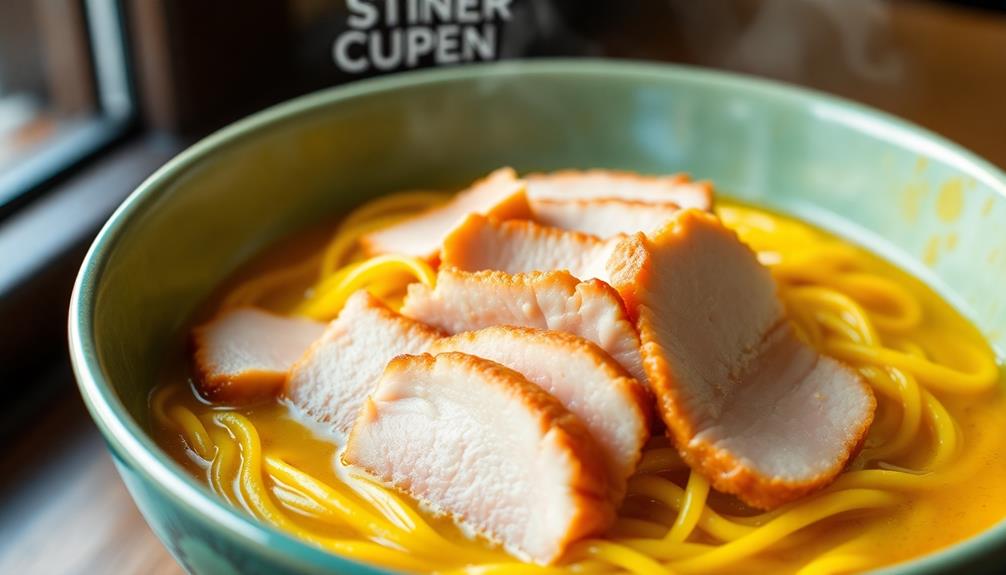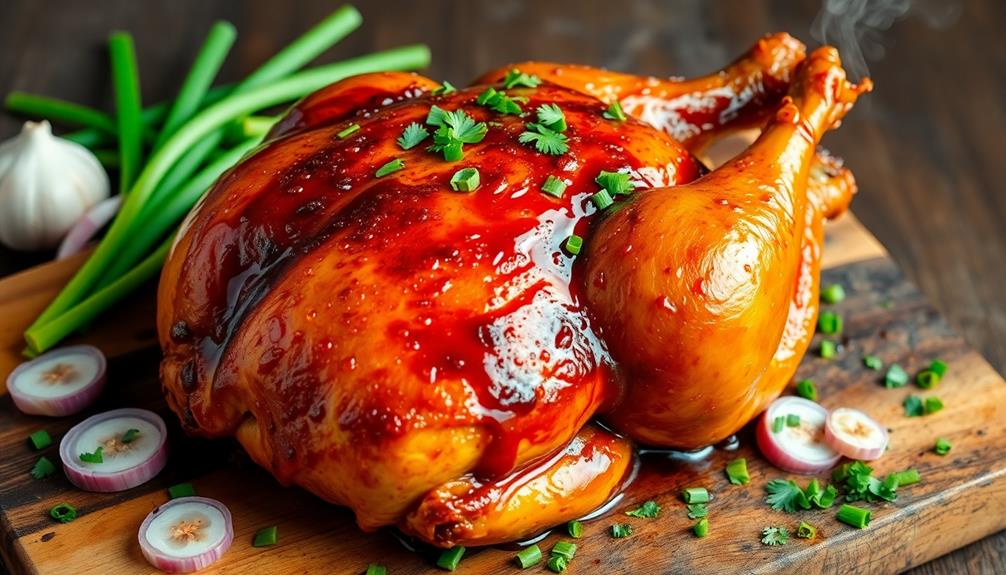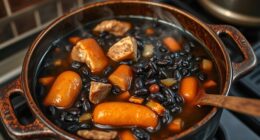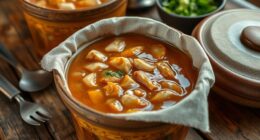Prepare to embark on a flavorful journey through the vibrant culinary traditions of Vietnam! Mi Quang, the iconic noodle dish from the central province of Quang Nam, is a mouthwatering masterpiece. You'll find chewy, golden-hued rice noodles nestled in a rich, savory broth, topped with tender pork, succulent shrimp, and a medley of fresh herbs and crunchy veggies. This harmonious blend of textures and flavors has been passed down through generations, celebrating the region's unique culinary heritage. Get ready to explore the joy of discovering new tastes and techniques that make Mi Quang a true delight for the senses.
Key Takeaways
- Mi Quang is a signature noodle dish originating from Quang Nam province in central Vietnam, known for its unique culinary heritage and attention to detail.
- The dish features chewy, turmeric-infused rice noodles served in a rich, flavorful broth, accompanied by a variety of proteins and fresh garnishes.
- The recipe has been passed down through generations, with family-specific variations, showcasing the diversity of Vietnamese cuisine.
- The balanced flavors and vibrant colors of Mi Quang make it a popular choice for both restaurant dining and home cooking.
- Exploring the traditions and techniques behind Mi Quang offers a delightful way to discover the rich culinary landscape of Vietnam.
History
Mi Quang, a beloved noodle dish from the Quang Nam province of central Vietnam, has a rich and storied history that dates back centuries. This iconic dish evolved from the unique culinary traditions of the region, blending the flavors of the land with the bounty of the nearby rivers and sea.
Over time, the recipe has been passed down through generations, each family adding their own special touch to create the irresistible flavor profile we know and love today.
What makes Mi Quang so special is the careful attention to detail in its preparation. The noodles are made from a blend of rice and turmeric, giving them a vibrant golden hue and delicate texture.
The broth is simmered with a medley of aromatic spices, creating a depth of flavor that tantalizes the senses. Topped with an array of fresh herbs, crunchy peanuts, and succulent proteins, each bite of Mi Quang is a celebration of the rich culinary heritage of central Vietnam.
Recipe
Mi Quang is a beloved Vietnamese noodle dish that originated in the Quang Nam province. This regional specialty features chewy, turmeric-infused noodles in a rich, flavorful broth, topped with a variety of proteins and fresh herbs.
The vibrant colors and balance of flavors in Mi Quang make it a truly unique and satisfying dish. The combination of tender pork, shrimp, and a medley of crunchy vegetables creates a harmonious texture and taste experience.
Ingredients:
- 8 oz rice noodles
- 1 lb pork shoulder, thinly sliced
- 1/2 lb shrimp, peeled and deveined
- 3 cups chicken or pork broth
- 2 tbsp fish sauce
- 1 tsp sugar
- 1 tsp turmeric powder
- 2 cloves garlic, minced
- 1 cup bean sprouts
- 1/2 cup chopped green onions
- 1/4 cup chopped cilantro
- 2 lime wedges
Cooking Instructions:
In a large pot, bring the broth to a simmer over medium heat. Add the fish sauce, sugar, and turmeric, and stir to combine.
Add the pork and shrimp, and continue to simmer until the proteins are cooked through, about 5-7 minutes.
Meanwhile, prepare the noodles according to package instructions.
To serve, divide the noodles among bowls, and ladle the broth and proteins on top. Garnish with the bean sprouts, green onions, cilantro, and a squeeze of lime.
When cooking Mi Quang, it's important to use high-quality, fresh ingredients to ensure the best possible flavor.
The broth should be rich and well-seasoned, and the noodles should have a slight chew.
Experiment with different protein options, such as chicken or beef, to find your perfect combination.
Cooking Steps
First, you'll need to soak the rice noodles in warm water until they're nice and soft.
Once they're ready, drain and rinse the noodles.
Next, add the sliced pork to the noodles.
Step 1. Soak Rice Noodles in Warm Water

To prepare the rice noodles, you'll want to soak them in warm water. This helps soften and rehydrate the noodles, making them nice and pliable.
Start by filling a large bowl with warm water, around 100-110°F (37-43°C). Gently place the dried rice noodles into the water, making sure they're fully submerged.
Let them soak for about 15-20 minutes, stirring occasionally, until the noodles have become soft and flexible. You'll know they're ready when you can easily bend a strand without it breaking.
Drain the noodles in a colander, then give them a quick rinse under cool running water. This helps remove any excess starch.
Now your noodles are prepped and ready to be added to the flavorful Mi Quang broth and other tasty ingredients. Get ready for a delicious and authentic Vietnamese noodle experience!
Step 2. Drain and Rinse Noodles

After letting the rice noodles soak, it's time to drain and rinse them. Grab a colander or strainer and carefully pour the noodles into it. The noodles should have softened up nicely and be ready to use.
Quickly rinse the noodles under cool, running water. This helps remove any excess starch, ensuring your Mi Quang has the perfect texture. Gently swish the noodles around with your fingers to fully rinse them. You'll see the water turn a bit cloudy as the starch washes away.
Once the noodles are rinsed, give the colander a few good shakes to help drain off any remaining water. You don't want your noodles to be dripping wet when you add them to the dish. Just a light coating of moisture is perfect.
With the noodles drained and rinsed, you're all set to start assembling your delicious Mi Quang!
Step 3. Add Sliced Pork to Noodles

With the noodles now drained and rinsed, it's time to add the sliced pork.
Grab a few thin, tender slices of pork and gently place them on top of the steaming noodles. The pork should sizzle and brown, filling the air with a mouthwatering aroma.
Use your chopsticks to carefully mix the pork into the noodles, making sure each strand is coated in the savory flavors. As the pork cooks, it'll become deliciously tender and juicy, complementing the chewy texture of the noodles perfectly.
Give the dish a few more stirs to ensure everything is well combined. Now you're ready to enjoy your Mi Quang noodles with the tasty addition of the sliced pork.
The blend of flavors and textures is sure to delight your taste buds and leave you craving more of this Vietnamese specialty.
Step 4. Add Broth to Noodles

Next, you'll want to add the hot broth to the noodles. This is where the dish really comes to life! Carefully pour the fragrant, steaming broth over the noodles, making sure to cover them completely. Finally, it’s time to add the finishing touches to your dish. Once you’ve added the hot broth to the noodles, you can then top them with your choice of ingredients. Some popular additions to tofu and shrimp paste noodles include sliced tofu, shrimp, and a drizzle of savory shrimp paste. These toppings will add even more flavor and texture to your already delicious dish. Enjoy your tofu and shrimp paste noodles while they’re still hot!
You'll notice the noodles start to soften and soak up all that delicious flavor. Inhale deeply – can you smell the tantalizing aromas of lemongrass, ginger, and savory spices? That's the magic of the broth!
Give the noodles a gentle stir, allowing the broth to evenly distribute. Watch as the vibrant colors of the sliced pork, bean sprouts, and fresh herbs come together in one mouthwatering bowl.
Now, prepare to be dazzled. The hot broth, combined with the chewy noodles and array of textures, is about to take your tastebuds on a flavor adventure.
Get ready to slurp up every last drop of this authentic Vietnamese delicacy!
Step 5. Add Garnishes

The final flourish to your Mi Quang noodle masterpiece comes in the form of vibrant garnishes.
Start by tearing a few sprigs of fresh mint and cilantro. Their bright, verdant hues and aromatic flavors will instantly lift the dish.
Toss in a handful of crisp bean sprouts for a satisfying crunch. Don't forget the tangy pickled carrots and daikon – their zesty punch balances the richness of the noodles.
For a pop of color, top it all off with sliced red chilies. Their fiery kick will tantalize your taste buds.
Finally, a squeeze of fresh lime juice brightens the entire bowl, cutting through the savory broth.
Arrange the garnishes artfully, turning your Mi Quang into a true work of culinary art.
Each vibrant element adds its own unique texture and flavor, transforming your noodle bowl into a sensory delight.
Get ready to dig in and enjoy the full taste experience!
Final Thoughts
Mi Quang, a vibrant and flavorful Vietnamese noodle dish, has captivated our taste buds throughout this exploration.
As we've learned, this dish is a delightful balance of textures and flavors, with the chewy noodles, crunchy garnishes, and savory broth coming together in perfect harmony.
Now that you've had a chance to try your hand at making this delectable dish, we hope you'll continue to explore the rich culinary traditions of Vietnam.
Whether you're dining at a local Vietnamese restaurant or experimenting in your own kitchen, the joy of discovering new flavors and techniques is truly unparalleled.
Frequently Asked Questions
What Is the Difference Between Mi Quang and Other Vietnamese Noodle Dishes?
The key difference between mi quang and other Vietnamese noodle dishes is the distinct regional flavor profile. While they may share common ingredients, mi quang has a unique taste that sets it apart from its counterparts across the country.
Can Mi Quang Be Made With Different Types of Meat?
Yes, you can make this dish with different types of meat. Typically, it's made with pork, but you can also use chicken, shrimp, or even a combination of proteins to create your own unique version.
How Long Do the Noodles Need to Be Cooked For?
The cooking time for the noodles depends on the type you're using. Generally, you'll want to cook them for 2-3 minutes until they're tender but still have a bite. Follow the package instructions to get the best results.
Is Mi Quang Gluten-Free or Suitable for Those With Dietary Restrictions?
Yes, mi quang can be gluten-free if you use rice noodles instead of wheat-based ones. It's also suitable for those with dietary restrictions like vegetarians, as you can omit the pork and make it a vegan dish.
Where Can I Find the Unique Ingredients Used in Mi Quang?
You can find the unique ingredients used in this dish at Asian grocery stores or specialty markets. Look for items like toasted peanuts, shredded pork, and turmeric-infused noodles, which are essential components of the authentic mi quang flavor profile.










